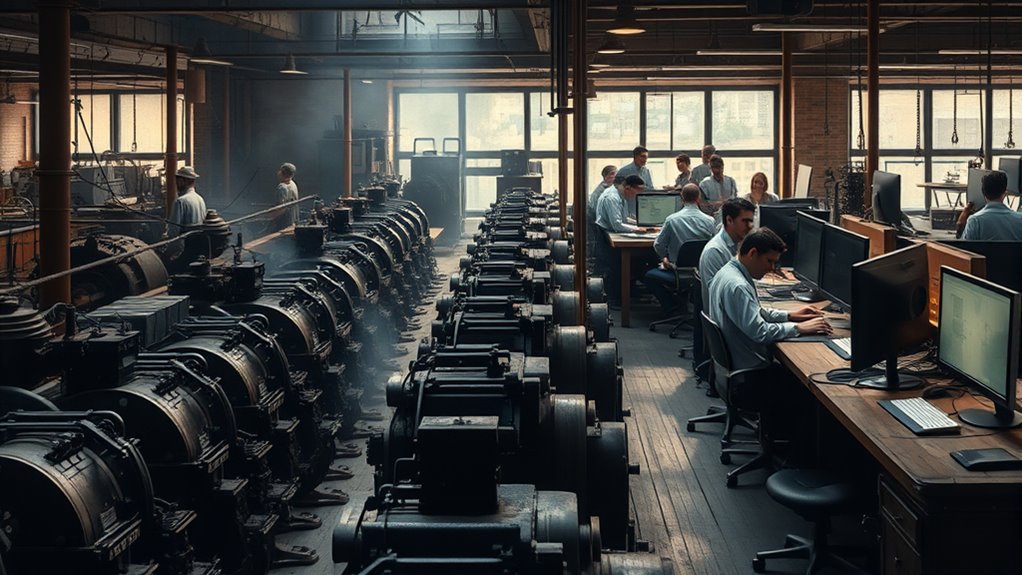Throughout history, technological advances—from the Luddites’ fight against factory machinery to today’s AI—have dramatically changed how we work and share wealth. Early protests arose when machines replaced skilled labor, leading governments to suppress worker movements. Over time, innovations often increased wealth for the few while marginalizing others, a pattern still visible today with digital and AI-driven inequalities. If you continue exploring, you’ll uncover how these shifts shape our society and future opportunities.
Key Takeaways
- Historically, technological advances like the Industrial Revolution displaced manual jobs but also created new skilled roles, shaping wealth distribution.
- Worker resistance, from Luddites to modern protests, reflects recurring fears of job loss and inequality caused by technological change.
- Governments have historically used laws and force to control worker organization, often favoring corporate interests over labor protections.
- Technological progress tends to concentrate wealth among elites, widening social inequality and deepening class stratification over time.
- Adaptation through reskilling, policy intervention, and inclusive innovation is essential to ensure equitable economic benefits from technological shifts.
The Rise of the Luddites and Early Resistance

The rise of the Luddites and their early resistance emerged in response to the rapid technological changes during the Industrial Revolution. It all started in Arnold, Nottinghamshire, on March 11, 1811, as workers protested against automated textile machines threatening their jobs. During this period, economic hardship worsened by the Napoleonic Wars, inflation, and high unemployment pushed workers to defend their livelihoods. The Luddites targeted machinery that replaced skilled labor, smashing it in secret nighttime meetings on the moors. Their actions spread across the North West and Yorkshire between 1811 and 1816, showing widespread anxiety about job security. The movement reflected workers’ fears of losing economic stability and enduring poor factory conditions amid a tumultuous and uncertain economy. The name “Luddite” appeared in writings as early as 1811, symbolizing their resistance against the mechanization that threatened their traditional crafts and skilled work. Additionally, the movement exemplified early worker resistance to technological disruption and the social upheaval it caused.
Technological Innovation and Its Socioeconomic Effects

As society grapples with the ongoing waves of technological change, innovations like AI, biotechnology, and energy advancements are reshaping economies and daily life. You’ll notice AI automates tasks, boosting productivity but displacing jobs, especially in routine sectors. Biotechnology and nanotechnology bring breakthroughs in healthcare and economic growth, yet they also raise ethical questions. Technological progress can accelerate growth but often widens wealth gaps if benefits aren’t shared fairly. Energy innovations reduce emissions but demand significant investments. Meanwhile, the digital revolution deepens the global digital divide, impacting social interactions and economic opportunities. These changes lead to shifts in employment patterns, emphasizing skilled roles, and can create new jobs in emerging fields. However, they also challenge social equity and require ongoing adaptation for workers and societies alike. Additionally, the integration of new technologies can influence home improvement practices by encouraging smarter, more sustainable living environments. Furthermore, advancements in projector technology exemplify how innovation continues to shape our everyday experiences, from entertainment to education. The increasing reliance on digital tools also highlights the importance of cybersecurity measures to protect sensitive information in this evolving landscape. Moreover, fostering creative practice can help individuals develop innovative solutions to adapt to these technological changes and contribute to a more resilient society. Embracing technological literacy is crucial for ensuring all members of society can participate fully in the modern economy.
Government Actions and the Suppression of Worker Movements
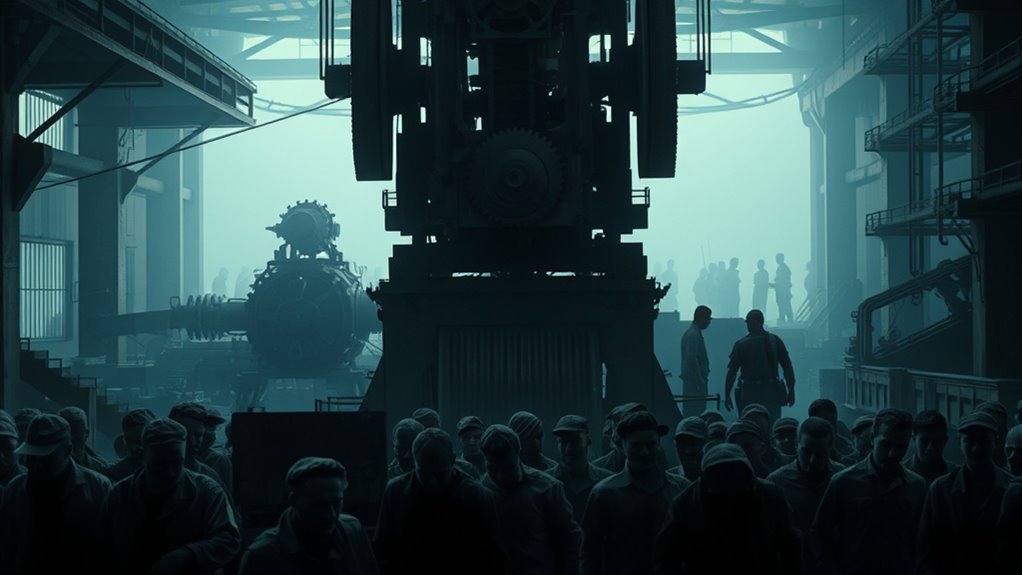
You see, governments have long used tactics like force, legal restrictions, and intimidation to hinder worker movements. These actions often prioritize protecting employer interests over workers’ rights, making organizing and striking difficult. Understanding these strategies helps explain why labor struggles have faced persistent suppression throughout history. Furthermore, state and federal laws have increasingly favored corporations by weakening labor protections and enforcement, further hindering organized labor efforts. Additionally, the hours of operation at supermarkets and other retail outlets can influence how and when workers are able to organize or participate in actions, affecting the overall dynamics of labor movements. The regulatory landscape continues to evolve in ways that can either support or suppress collective worker action.
Government Suppression Tactics
How did governments and employers collaborate to suppress worker movements during the rise of industrialization? They used police, militia, and troops to break strikes, often resulting in violence and death. Pinkerton agents and state forces worked together, as seen in the Homestead Strike, where union leaders faced defeat. Federal troops ended railway blockades during the Pullman Strike, ensuring mail trains ran but crushing protests. Employers, Citizens’ Alliance, and the National Guard expelled miners’ unions in Colorado. They also protected strikebreakers and undermined picket lines. Public perception was shaped through propaganda portraying workers as threats. Below is a snapshot of their tactics:
| Tactic | Example |
|---|---|
| Use of force | Homestead, Pullman, Colorado Labor Wars |
| Collaboration | Employers, Citizens’ Alliance, National Guard |
| Propaganda | Media framing workers as anarchists or threats |
Legal Worker Protections
Legal worker protections emerged as a response to the widespread repression of labor movements during industrialization, with governments and employers working together to limit workers’ rights and suppress collective action. Early laws like the Keating–Owen Act and Child Labor Tax Law aimed to regulate child labor but faced judicial rejection and lacked enforcement. State inspections and safety rules laid groundwork but had limited impact. The 1938 Fair Labor Standards Act marked a turning point, establishing minimum wages, overtime, and child labor standards. Civil rights laws later expanded protections against discrimination and wage disparities. Government agencies like the Department of Labor enforce these laws through inspections, fines, and legal action. Still, enforcement gaps, judicial interference, and incomplete coverage show ongoing challenges to worker protections.
- Laws often faced judicial rejection, delaying progress
- Enforcement resources remain limited, hindering compliance
- Broadened protections still struggle to reach all workers
Shifts in Wealth Distribution and Societal Impact
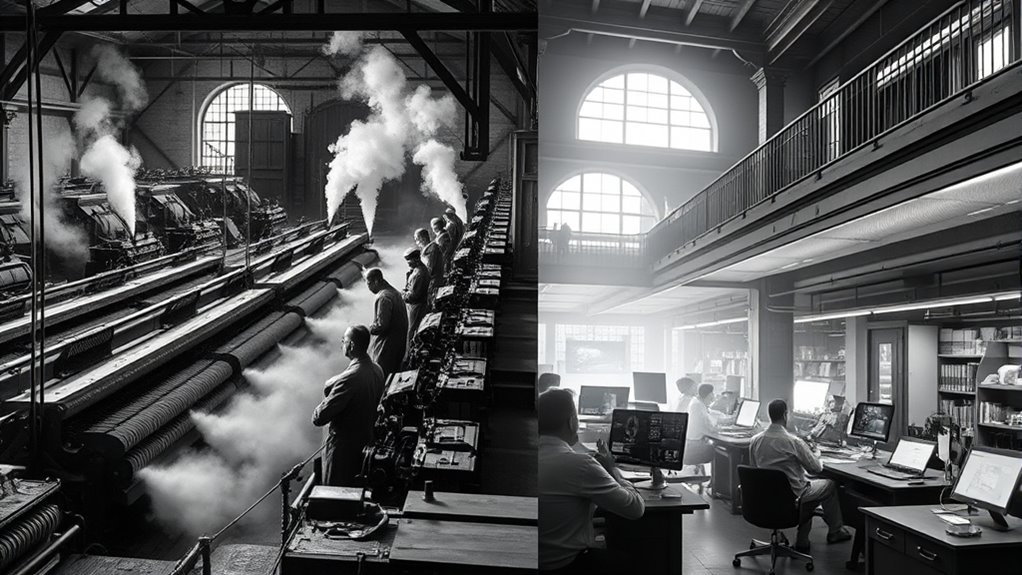
Recent shifts in wealth distribution reveal a growing divide that profoundly impacts society. Over the past century, wealth has become increasingly concentrated at the top. The top 10% held between 60–90% of total wealth, with the ultra-rich, the top 0.1%, experiencing sharp rebounds after mid-century declines. Meanwhile, the middle class peaked mid-century and has since declined, and the bottom 50% consistently owns almost no net wealth. Since 1980, income inequality has surged, with the top 5% seeing rapid income growth, while lower groups face stagnation or decline. Wealth increasingly accumulates among older, wealthier generations, reducing social mobility. These disparities deepen social tensions, limit opportunities for many, and grant the wealthy more political influence, threatening societal cohesion and economic stability. Wealth concentration at the top continues to rise, making economic disparities more entrenched. Additionally, the role of data analysis by AI in understanding these trends is growing, providing insights that could inform policy responses and promote equitable wealth distribution. Moreover, advancements in AI-powered analytics are enabling more precise identification of inequality patterns, aiding policymakers in crafting targeted interventions. Understanding the impact of technology on wealth reveals how innovations can both challenge and reinforce existing disparities, emphasizing the need for informed policies. Recognizing the importance of biodiversity and sustainable practices can also inform more equitable and resilient economic strategies that benefit society as a whole.
Parallels Between Past and Present: From Factories to AI
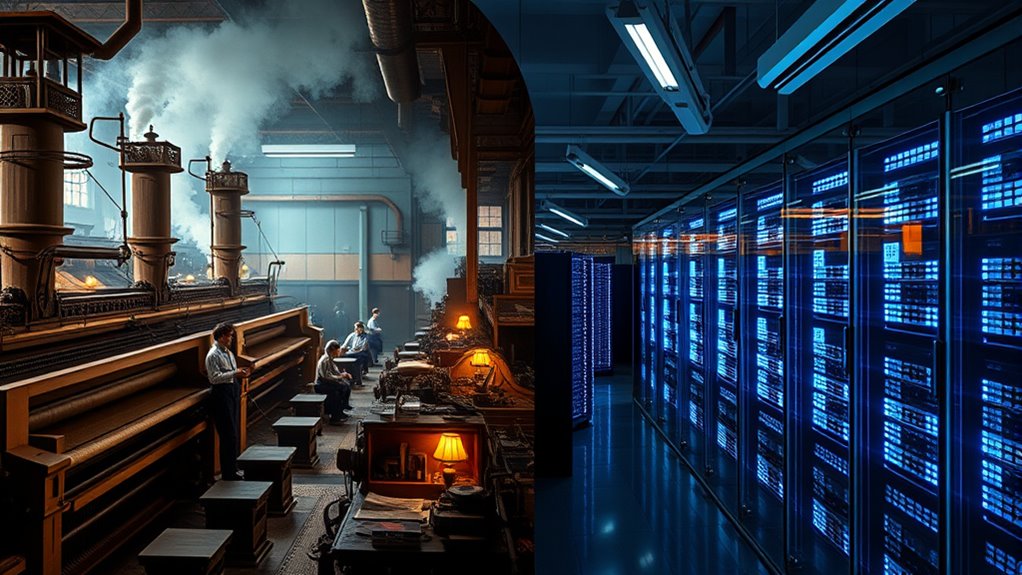
Just like workers once resisted factory automation, many today push back against AI replacing jobs. As machines shift skills and tasks, you see similar concerns about workers losing their expertise and independence. Meanwhile, wealth gaps grow wider, echoing past disparities caused by technological change. Interestingly, Forsale 100 reflects the ongoing shift in economic landscapes, highlighting how market dynamics adapt in response to technological innovations. This pattern reveals how technological displacement continues to reshape societal structures over time, often leading to discussions about economic inequality and its societal impacts. Additionally, the integration of rural aesthetic elements in modern design demonstrates how cultural shifts influence perceptions of progress and tradition. Incorporating sound healing science principles into workplace wellness programs could further bridge the gap between technological advancement and human well-being.
Factory Automation Resistance
Have you ever wondered why workers have historically resisted technological change in factories? It’s because they feared losing their jobs and livelihoods. The Luddite movement in the early 1800s saw textile workers smashing machines to protect their employment. Governments responded with military force, highlighting the widespread anxiety. Similar fears persist today with AI and automation, though resistance is less violent and more political, like lobbying and regulation debates. Workers worry not only about low-skill jobs but also about white-collar roles. These protests reflect a recurring theme: technology disrupts communities and job security.
- Resistance arises from fears of job loss and social instability
- Governments historically used force to suppress protests
- Workers’ concerns extend beyond manual labor to cognitive roles
Skill Shift Challenges
Throughout history, technological advances have consistently reshaped the skills workers need to stay employed. During the Industrial Revolution, mechanization replaced manual skills, forcing workers to learn new techniques. The Luddites pushed back against this change, but new roles eventually emerged. Today, AI and automation demand cognitive, digital, and analytical skills rather than manual tasks. Jobs involving repetitive work are most vulnerable, while roles in data analysis, programming, and digital collaboration grow more vital. Reskilling has become a continuous necessity, unlike past waves where training was episodic. Workers face skill mismatches, and adapting quickly is essential for job security. Governments and companies now prioritize lifelong learning, but failure to keep pace risks long-term unemployment. Overall, skill shifts remain a core challenge in steering technological progress.
Wealth Disparity Trends
As technology transforms economies today, the patterns of wealth disparity mirror those seen during the Industrial Revolution. Back then, wealth concentrated among the elite, while the poor remained largely impoverished. Income inequality widened, with the top 10% globally holding over half of the wealth, similar to today’s trends with AI and digital tech. Both eras saw social stratification deepen, benefiting the wealthy and marginalizing others. The digital age, like industrialization, creates new opportunities for some to amass wealth while leaving many behind. Resistance from affected groups persists, echoing Luddites’ protests. Understanding these parallels helps you see how technological change can reinforce existing inequalities unless policies address access, education, and regulation.
- Both periods see new technologies creating wealth for elites and hardship for others
- Global income gaps widen despite economic growth
- Policy and education are key to reducing disparities
Navigating the Future of Work in a Tech-Driven World
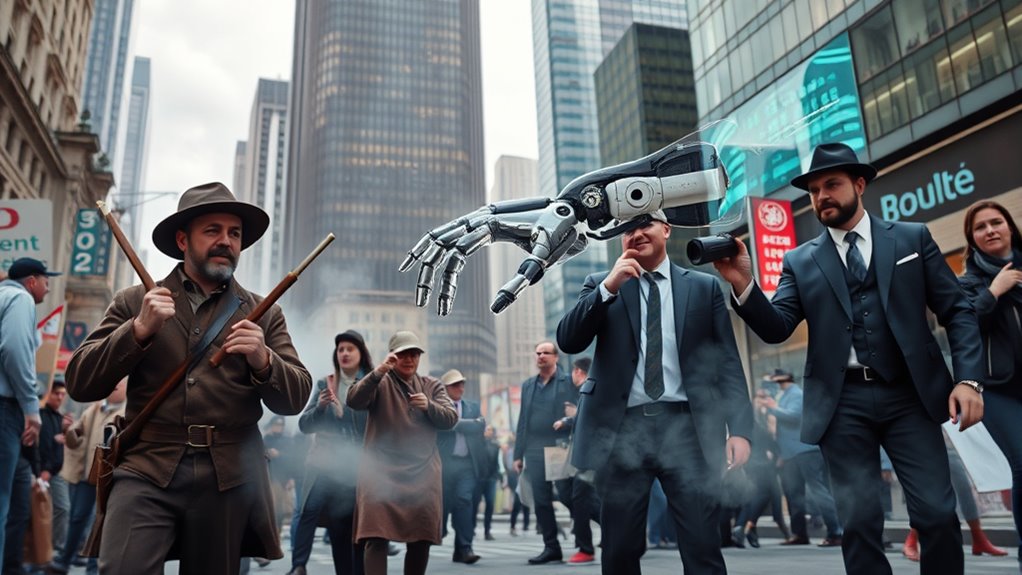
Exploring the future of work in a tech-driven world requires understanding how rapid advancements like generative AI and robotics are reshaping industries and job roles. You’ll see digital access transforming 60% of businesses by 2030, making remote work and flexible arrangements more common. Automation will displace around 92 million jobs globally but create 170 million new roles, especially in tech, green, and care sectors, leading to a net gain of 78 million jobs. To stay competitive, you need to reskill in AI literacy, data analytics, and cybersecurity. Employers are shifting toward skills-based hiring and personalized learning. Expect more remote, flexible, and diverse work models, but also be aware of challenges like youth unemployment and unequal access. Staying adaptable is essential to navigate this evolving landscape successfully.
Frequently Asked Questions
How Did Luddites Influence Modern Labor Rights Movements?
You see, Luddites greatly influenced modern labor rights movements by highlighting the need to protect workers from unchecked technological changes. Their acts of collective resistance set a precedent for unionization and advocacy for safer, fairer workplaces. Today, you can trace their legacy in ongoing struggles for job security, fair wages, and safe conditions amid automation and AI, showing that workers continue to unite for their rights against technological shifts.
What Lessons From the Luddites Era Apply to Ai-Driven Automation?
You can learn that when new technology threatens jobs, social unrest often follows, especially if workers aren’t included in benefits or decision-making. The Luddites show the importance of fair transition strategies, like shared ownership or profits, to reduce conflict. Transparency and cooperation matter; you should focus on policies that protect livelihoods and involve workers in shaping technological change to prevent violence and guarantee smoother adaptation.
How Have Government Policies Evolved in Response to Technological Unemployment?
Imagine the economy’s landscape shifting beneath your feet as new tech emerges. Governments have responded by planting strategic safety nets—public works, welfare, retraining programs—to catch those displaced. You see policies like TAA grow stronger, offering support like a sturdy bridge over turbulent waters. Over time, these efforts evolve, aiming to help workers navigate the storm of innovation, ensuring no one is left stranded in the wake of progress.
In What Ways Do Technological Disruptions Impact Income Inequality Today?
You see, technological disruptions today tend to widen income inequality because AI boosts high-income workers’ productivity and wages more than lower-wage workers, who often get left behind. Capital owners benefit from increased returns, while middle- and low-skill jobs face automation or displacement. This shift favors wealthier regions and individuals, deepening economic divides both within and between countries, making it harder for everyone else to catch up.
Can Society Balance Innovation Benefits With Protecting Vulnerable Workers?
You need to strike a balance between embracing innovation and safeguarding vulnerable workers. It’s a tightrope walk, but with proactive policies like reskilling programs, income support, and fair regulations, you can guarantee progress doesn’t leave people behind. Collaboration between government, industry, and education is key. By staying adaptable and investing in lifelong learning, society can harness technology’s benefits while providing a safety net for those in transition.
Conclusion
You might think technology always leaves workers behind, but history shows it also creates new opportunities. Just as the Luddites fought change, today’s AI can seem intimidating. Yet, embracing innovation can help you adapt and thrive in the evolving job landscape. Don’t fear progress—use it to your advantage. The key is staying flexible and informed, turning challenges into chances for growth in this ever-changing world of work.
